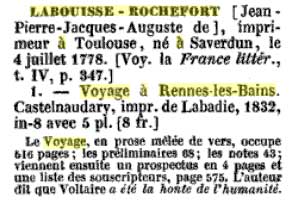 Jean Pierre Jacques Auguste de Labouïsse-Rochefort was born in Saverdun (Ariège) on 4th July 1778 and died in Castelnaudery (Aude) on 22nd February 1852. He was a French historian. In 1832 he published a book entitled ‘Voyage à Rennes-les-Bains’ in which he described a treasure, guarded by the devil close to the Château de Blanchefort. According to the locals, he recounts, it concerned nineteen and a half million pieces of gold.
Jean Pierre Jacques Auguste de Labouïsse-Rochefort was born in Saverdun (Ariège) on 4th July 1778 and died in Castelnaudery (Aude) on 22nd February 1852. He was a French historian. In 1832 he published a book entitled ‘Voyage à Rennes-les-Bains’ in which he described a treasure, guarded by the devil close to the Château de Blanchefort. According to the locals, he recounts, it concerned nineteen and a half million pieces of gold.
Once a nice sunny day, the devil put the gold on display where it was spotted by a young sheperdess who lived close to the site. When she returned with her parents, the treasure had disappeared. A sorcerer was called in for help. The sourcerer tells the villagers he is prepared to help if he gets half of the treasure and the help of the villagers in catching the devil.
The sorcerer went on a search for the devil. When the villagers heared a great noise they got afraid and fled. The sorcerer left for Limoux, disappointed and angry.
Labouisse-Rochefort then describes that the Marquis de Fleury, who owned the ruins of Blanchefort, threatened to sue the villagers for violating his terrains, linking this tale to actual facts.
Labouisse-Rochefort ends with a little poem about the treasure:
 Comme un misérable nu
Comme un misérable nu
Avec sa mine hagarde
Le front chauve et biscornu
Armé d’une hallebarde
Au pied de ce mont chénu
L’ange de race bâtarde
Au ton sec et saugrenu
Tient constamment sous sa garde
Cet immense revenu
Que de ce roc je regarde
Comme si j’étais venu
Pour lui monter une garde
Et voler ce contenu
Que de céder il n’a garde
Labouisse-Rochefort’s description of this local legend demonstrated that the historical roots of the Mystery of Rennes-le-Château are much older than the story of Abbé Saunière. There was talk of a local treasure long before he surfaced.
Noel Corbu was clearly inspired by this book. In the tape recording he made to entertain the guests of his hotel he too spoke of nineteen-and-a-half million pieces of gold.
Book cover of ‘Voyage à Rennes-les-Bains copyright Morgan Roussel


Auguste also wrote the work ‘The Lovers,to Eleonore’ with ‘Et in Arcadia Ego’ on its title page. A reference to the ‘Lincoln Cathedral code’ and its shepherdess Eleanor whose statue stares over at the marker tomb where a Templar treasure may reside?
There can be no doubt that he was also a member of the angelic society along with victor hugo george sand gaston le roux alexander dumas jules verne and other authors at the time whose motto was et in arcadia ego as i have explained in my book The poussin enigmaand who knew of the location of the treasure and secret of rennes-le chateau.
There can be no doubt that he was also a member of the Angelic Society along with victor hugo george sand gaston le roux alexander dumas jules verne eugene delacroix debussy and others at the time whose motto waset in arcadia ego and who knew the location of the treasure and the secret of rennes-le chateau as i have explained in my book The poussin enigma.